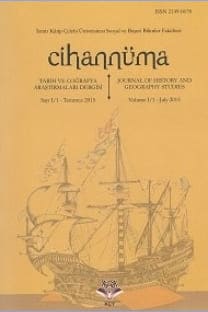Ruscuk'dan Besarabya'ya: Manuk Bey ve Bir Osmanlı-Rus Aracısı'nın 19. Yüzyıl Başındaki Kariyeri
Ruscuk ayanı Alemdar Mustafa Paşa’nın sarraf ve yardımcısı olan Ermeni Manuk Mirzayan’nın (ö. 1817), hayatı ve siyasi kariyeri 19. yüzyılın ilk yarısında Osmanlı-Rus bir arabulucunun stratejilerini anlamak açısından çok iyi bir örnek sunar. Aynı dönemin Osmanlı Balkanlarının karmaşık iç ve dış denge ve problemlerinin bir ürünü olan Manuk Bey, iki imparatorluk arasındaki çekişmelerde kurnaz bir şekilde ayakta kalmayı becermekle kalmamış, bir aracı olarak bu çekişmelerden faydalanmayı da bilmiştir. Ruscuk’tan Besarabya’ya kadar uzanan hayat hikayesini takip eden bu çalışmada spekülasyon ve öngörüleriyle hareket edebileceği ve iki imparatorluğun çatışan çıkarlarına hizmet eden aracı ve ajanların avantajlı olduğu bu karmaşık ortamda Manuk Bey’in statüsünü yükseltme ve ayakta kalma stratejileri incelenecektir.
From Ruscuk to Bessarabia: Manuk Bey and the Career of an Ottoman-Russian Middleman at the Beginning of the 19th Century
The life and political career of Manuk Mirzayan (d. 1817), the Armenian money-lender and acolyte of Mustapha Pasha Bairaktar, the ayan of Ruscuk, presents a good case of study of a Ottoman-Russian middleman of the early 19th century Balkans. As a product of the complicated internal and international problems of the Ottoman Balkans, he aptly managed to survive amongst the conflict between two empires and even benefited from the international conflicts as a middleman. By tracing his activities from Ruscuk to Bessarabia, this paper argues that Manuk’s decisions can be considered as strategies to improve his status and secure his life in an environment about which he could only speculate but which clearly favored agents who could cater to the competing interests of different empires and political factions.
Keywords:
Manuk Mirzayan, Balkans, Russia Ottoman Empire,
___
- Archival Fund H.Dj. Siruni at the National Archives of Romania in Bucharest, no. 1464, 1466-1469. (DANIC)
- Academia Romana, Istoria Romanilor, vol. 6, (Bucharest: Editura Enciclopedica, 2003).
- Arachelian, V., Munca unui savant armean in Romania, (Bucharest: Biblioteca Bucurestilor, 2008).
- Bezviconi, G., Boierimea Moldovei dintre Prut si Nistru. Actele Comisiei pentru cercetarea docum nobilimii din Basarabia la 1821, (Bucureşti: Tritonic, 2004).
- Ciobanu, V., “Înfiinţarea consulatelor străine în Principatele Dunărene,” Istoria românilor, ed. by Paul Cernovodeanu, Nicolae Edroiu, vol. 6, (Bucharest, 2002), pp. 642–652.
- Costache, S. “The Ottoman-Russian-Habsburg Information Networks and the Negotiation of Ottoman Affairs on the Danube (1800s-1820s)”, Revista istorică XXVI/3-4 (2015), pp. 249-79.
- Goşu, A., La Troisième Coalition Antinapoléonienne et la Sublime Porte: 1805, (Istanbul: Isis, 2003).
- Hamilton, K. and Langhorne, R., The Practice of Diplomacy: its evolution, theory and administration, (New York: Routledge, 2011).
- Ionescu, S., Manuc Bei, Zaraf si diplomat la inceputul secolului al XIX-lea, (Cluj-Napoca, Editura Dacia, 1976).
- Karadja, I.C., “Corespondenţa lui Capodistria cu Ioan Caragea Vodă,” Revista Istorică 7, no. 7-9 (1921), pp. 181-89.
- Miller, Anatolii F., Mustapha Pacha Bairaktar, (Bucharest: Association Internationale d’Etudes du Sud-Est Européen, 1975).
- Mustafa A. Mehmet, Documente turcesti privind istoria Romaniei, 1791-1812, vol. III, (Bucharest: Editura Academiei RS România, 1976-1986).
- The Diplomat’s World: A Cultural History of Diplomacy 1815-1914, editors Markus Mosslang și Torsten Riotte, (New York: Oxford University Press, 2008).
- ISSN: 2149-0678
- Yayın Aralığı: Yılda 2 Sayı
- Başlangıç: 2015
- Yayıncı: İzmir Katip Çelebi Üniversitesi
Sayıdaki Diğer Makaleler
Bir Rahibin Kaleminden Alemdar Mustafa Paşa’nın Sarrafı Manuk Mirzayan Bey
Silvart MALHASYAN, Aysel YILDIZ
Ziştovi ve Yaş Görüşmeleri Örneği Üzerinden Osmanlı Diplomasisini Okumak
Osmanlı Arkeolojisinin Tarihi: Arkeologların Kazmadığı Topraklar
Ruscuk'dan Besarabya'ya: Manuk Bey ve Bir Osmanlı-Rus Aracısı'nın 19. Yüzyıl Başındaki Kariyeri
İzmir Beit Hillel Sinagogu’nun Tefila Defteri ve Mustafa Kemal Paşa’ya Hanoten Teşua Duası
